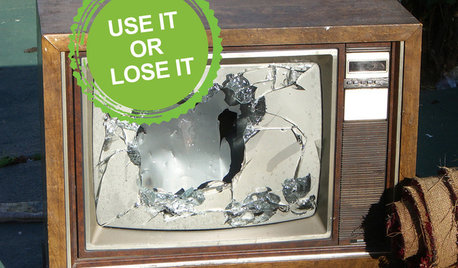How to get rid of cattails?
ncdirtdigger
12 years ago
Related Stories

MOST POPULARHow to Get Rid of Those Pesky Summer Fruit Flies
Learn what fruit flies are, how to prevent them and how to get rid of them in your home
Full Story
DECORATING GUIDESLose It: How to Get Rid of Old Light Bulbs
When the light goes out, you'll want to get rid of the bulb safely. Here's how
Full Story
DECORATING GUIDESUse It or Lose It: How to Get Rid of Old Keys
Clean out your junk drawer by getting rid of keys in an earth-friendly way
Full Story
DECLUTTERINGDownsizing Help: How to Get Rid of Your Extra Stuff
Sell, consign, donate? We walk you through the options so you can sail through scaling down
Full Story
DECORATING GUIDESLose It: 4 Ways to Get Rid of Your Old Carpet
Try one of these earth-friendly tips before stuffing your dingy carpet or rug in the trash
Full Story
GARDENING AND LANDSCAPING4 Good Ways to Get Rid of Mosquitos in Your Yard
Stay safe from West Nile virus and put an end to irksome itches with these tools and methods for a porch, patio or yard
Full Story
DECORATING GUIDESLose It: How to Get Rid of a Mattress
Updating your bedroom? Here's how to donate, reuse or recycle that mattress — and keep it out of the landfill
Full Story
MORE ROOMSHome Tech: Getting Rid of Wires Without Sacrificing Sound
Wireless home technology still isn't perfect, but new products are giving audiophiles choices
Full Story
DECORATING GUIDESCleaning Out: The Right Way to Get Rid of Electronics
Learn how to dispose of worn-out electronics in a safer, more Earth-friendly way
Full Story
EDIBLE GARDENSNatural Ways to Get Rid of Weeds in Your Garden
Use these techniques to help prevent the spread of weeds and to learn about your soil
Full StoryMore Discussions






dottie_in_charlotte
dottie_in_charlotte
Related Professionals
Forest Acres Landscape Architects & Landscape Designers · Harvey Landscape Architects & Landscape Designers · Forest City Landscape Architects & Landscape Designers · Mount Wilson Landscape Architects & Landscape Designers · Cupertino Landscape Contractors · El Mirage Landscape Contractors · Florham Park Landscape Contractors · Goodlettsville Landscape Contractors · Hannibal Landscape Contractors · Overland Park Landscape Contractors · Palatine Landscape Contractors · Red Oak Landscape Contractors · Saint George Landscape Contractors · Setauket-East Setauket Landscape Contractors · Tuscaloosa Landscape Contractorsnandina
Lynda Waldrep
dottie_in_charlotte
Lynda Waldrep
basil_davis2
ncdirtdiggerOriginal Author
plantbug
tamelask
basil_davis2
dottie_in_charlotte
ncdirtdiggerOriginal Author
nancyofnc
dottie_in_charlotte
plantbug
tamelask
basil_davis2
basil_davis2
dolzadell
K